Top News
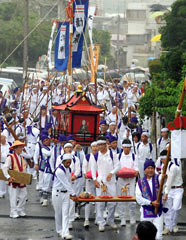
September 25, 2012 Ryukyu Shimpo
On September 24, the Gan-go Festival was held in the area around the Takayasu Public Hall in Tomigusuku. The festival is held once every 12 years, on August 9 of the year of the Dragon in the Chinese lunar calendar, to wish for residents’ good health and prosperity. During the festival, the residents paid tribute to spirits by performing dances, bojutsu (stick fighting) and hatagashira, a parade carrying large flags.
Gan is a sacred palanquin used for carrying a coffin. It is said that the Gan of Takayasu was brought into the Takushi clan in the Tomigusuku district about 250 to 300 years ago. It was destroyed during the Battle of Okinawa but a replica was created in 1952. Once every 12 years, in the year of the Dragon, people carry out repairs on the Gan and hold a festival to pray for the spirits of the Gan and for safety in the community.
Locals offered prayers from the morning and moved the Gan from where it was in storage to the public hall. Then, in front of the public hall, they performed hatagashira, bojutsu and dances to drive away bad luck. The mayor of Tomigusuku, Haruki Gibo, also participated in bojutsu and helped lift the spirits of the people. Separating into two groups, they then moved towards the east and west and performed dances and bojutsu in Takayasu.
During the finale, the participants carried the Gan about 400 meters from the public hall back to where it would be stored. Local residents and many tourists took part in the festival despite the rain, and it being held on a weekday.
(English translation by T&CT, Lima Tokumori and Mark Ealey)
Go to Japanese

Go To Video

October 1, 2012 Tamiko Suzuki Correspondent of Ryukyu Shimpo
On September 15, the Washington DC Okinawa Association held its annual picnic under a clear autumn sky in a park in Potomac, Maryland. Committee members and volunteers from the Okinawa-kai busied themselves setting up the tables, installing the sound equipment and getting the barbecue fires going. The spicy aroma from the bulgogi, a specialty of the Okinawa-kai, roast meat, hamburgers and hot dogs wafted around the barbeque. About 100 people, including members of the association, guests and family members with their children gathered to enjoy the good food.
After the master of ceremonies gave a welcome speech, while listening to music they all had lunch with fellow Okinawans, many of whom were meeting each other for the first time in a long time. The participants enjoyed the meal and conversation while soaking up the friendly atmosphere. Nestor Folta Jr., who participated in the Junior Study Tour to Okinawa during this summer, said, “I had a very positive experience in Okinawa.”
There were also recreations for children such as kusudama-wari (“split-the-decorative-paper-ball”) and suika-wari (“split-the-watermelon”). The participants cheered and applauded them along.
The most popular event was a workshop in which children learn how to make a bamboo-copter or a bamboo dragonfly. Parents and children worked together to complete their bamboo dragonflies, cutting the bamboo with their knives and launching them into the sky. A new event this year was a trial of breaking boards using karate skills. After selecting a board to match the physical size of each child, a karate master then taught the children how to hit the board. The children then demonstrated their ability to break the boards using a karate chop. All of those involved in this, adults as well as children, were satisfied with their efforts. There were also performances of folk music, line dancing and sanshin.
At the end of this event, the participants enjoyed the annual tug-of-war between men and women and the contest between people from Naha and from other municipalities. Hearing of the Okinawa-kai, a mother and child from Brazil (but of Okinawan origin) participated for the first time. A couple who studied at the University of the Ryukyus commented that they had not thought that there would be so many people at the event, and that they really enjoyed themselves.
(English translation by T&CT, Mark Ealey)
Go to Japanese
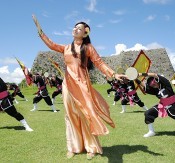
September 20, 2012 Ryukyu Shimpo
Ryukyukoku Matsuri Daiko has completed a film of Eisa-cise, which is a fusion of exercise and eisa that they invented. From October 6, which is during the Worldwide Eisa Festival 2012, the product will be available for a fee on DVD and for download. The project aims to promote health and eisa.
Eisa-cise focuses on training the muscles of the legs and hips, but especially the thighs. It has two levels of tempo – fast and slow, and people can work according to their age and physical capacity to avoid excessive strain.
The dance takes three minutes per song. The DVD includes practice videos filmed in a studio, group performance movies filmed at the World Heritage Site Nakagusuku Castle and an explanation of the effects of the exercise. Takeo Medoruma who is a director in the Ryukyukoku Matsuri Daiko choreographed the dances and musician Hidekatsu managed the music. He also arranged Jinjin, which is an Okinawan nursery rhyme, created the song to go with it.
The DVD sells for 1575 yen but sales channel have not been decided yet. The digital music costs 1575 yen and will be released at the follow site.
Website: http://www.eisa-cise.jp
Medoruma said, “It provides very effective exercise. Some of our people even said that they needed a rest after they did it twice. With world health being a catch-cry these days, I would like to take eisa to the world.” For details, call the company in charge of the project, Sun Agency, at 098 (862) 3577.
(English translation by T&CT, Lima Tokumori and Mark Ealey)
Go to Japanese
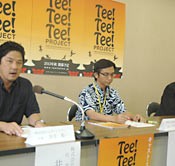
September 19, 2012 Ryukyu Shimpo
In October 2013, film production company Sugar Train, Inc., will open a permanent theater for plays composed of Okinawan performing arts such as Ryukyuan dance, eisa, and karate. The Okinawan Nonverbal Entertainment Performance “Tee! Tee! Tee! Project” will perform plays that even foreigners who don’t speak the local language can also enjoy. It seeks to create a new night tourist attraction that makes use of traditional culture.
On September 18, Representative Director Yuichi Ide announced the project at a press conference held at the Prefectural Government. The permanent theater will be equipped with a 400-seater portable tent that can also be used for performances outside Okinawa. It will be set up near a monorail station in Naha. There will be two performances a day for about 20 days a month. The company plans to sell tickets to travel agents, aiming to attract 115000 customers a year and earn 120 million yen in sales in the first year of operations.
The company will recruit 10 staff and performers by November 26. They plan to hold auditions and the successful candidates will be hired as fixed-term employees. Pilot “try-out performances” will be held from next January. Audience reviews of those performances will be collected through facebook and smartphone applications and they will then reflect on the performances from there. They will utilize the prefectural industrial promotion fund (15 million yen) and the cultural industry business model support project (three million yen).
At the press conference, Ide said, “We hope that it is really entertaining and serves as a starting point for people from all over the world to enjoy Okinawan culture. Okinawa Department of Culture, Tourism and Sports Director General Daiichi Hirata hopes that it will become a model for the cultural industry in Okinawa. Project partner Art Community Organization Okinawa Representative Hisashi Shimoyama said, “If this goes well, we can think about other projects that extend on from there.”
For more information about performers and staff recruitment call Sugar Train at 098 (882) 3123.
(English translation by T&CT, Megumi Chibana and Mark Ealey)
Go to Japanese

September 24, 2012 Ryukyu Shimpo
From September 23 (or August 8 in the lunar calendar) to September 25, the August dance festival, which is designated an Important Intangible Folk Cultural Property, was held on Tarama-jima. On the opening day, local people dedicated traditional performances of kyogen and kumi-odori to a good harvest in the coming year at the sacred site Ntabaru utakiugan at Nakasuji, Tarama. On September 24, at Pitoumata ugan, at Shiokawa, and on the next day, at the spiritual sites of Shiokawa and Nakasuji residents offered performances in a farewell ceremony.
At the Ntabaru utakiugan, people performed kumi-odori such as Chushin Nakasone Tuyumya gumi and Chukou Fujin. In Kumi-odori Chushin Nakasone Toyomiya gumi, Nakasone Toyomiya who was the ruler of Miyako-jima during the 16th century, conquered Onitora, the leader of Yonaguni-jima. This kumi-odori story is only performed in Tarama. The audience particularly enjoyed the fighting and heroic scenes and the sometimes comical movements.
Maina Sawada, a third-grade pupil of Tarama Junior High School, who made his last appearance in this event because he will graduate next year, said, “I am glad that I took part in our village’s traditional festival.” Masakatsu Tsukayama, the head of the Nakasuji community, said, “We are very grateful to participants from Ishigaki and Miyako, as well as those from Okinawa’s main Island and the main islands of Japan. I hope that many people enjoy themselves with the local residents.”
(English translation by T&CT, Mark Ealey)
Go to Japanese
September 25, 2012 Ryukyu Shimpo
On September 24, the Yonaguni Town Assembly voted on a bill proposing a referendum to ask the public about the construction of a Self-Defense Forces base in the island. The bill was rejected with two in favor and three opposed. Local residents initiated the bill but the assembly decided not to go ahead with a referendum because the bill was voted down. The members of the Yonaguni Reformation Conference who collected signatures for the initiative were dissatisfied with the assembly’s decision, and want to vote down the three assembly members who opposed the bill, as well as the chairman. While opposition party members Chiyoki Tasato and Toshio Sakimoto favored the bill, Kenichi Itokazu, Shigenori Takenishi and Sonkichi Sakihara, who are members of the ruling party, opposed it.
Both Tasato and Sakimoto stated the need to form a consensus with local residents by direct democracy process on the construction of a Self-Defense Forces base on the island. In contrast, Itokazu, Takenishi and Sakihara all claimed that isolated islands near national borders such as Yonaguni need to host a Ground Self-Defense Force coastal monitoring unit to the minimum extent necessary. They opposed the bill, saying, “The referendum could uproot the foundation of representative parliamentary democracy.”
The conference proposed a bill to directly seek the opinion of local residents on the matter of the deployment of Self-Defense Forces to the island, collecting 544 signatures in favor of the bill. It allowed residents older than junior high school age to vote, and asked for fair and neutral information to be provided by the municipal government in an explanatory meeting for local residents.
Yonaguni Town Mayor Shukichi Hokama supported the referendum as a way of dealing with the opposition views, saying, “Conflict among residents may actually generate the energy needed to help activate the island. I hope that agreement between both parties could help revitalize the island in the future.” Because of legal issues, Hokama requested that careful consideration be given to assigning votes to junior high school students and foreigners with permanent residence status.
Hokama supports the deployment of Self-Defense Forces to Yonaguni because he thinks it could bring advantages to the island such as curbing population decline, activating the island’s economy and helping in the event of a natural disaster.
After the bill was voted down by the assembly, Shoukichi Sakihara, the chairman of the conference said, “This is a tyranny of the majority. We need to vote down the assembly members who opposed the bill.” After the assembly meeting, Hokama said, “Both parties need to take a deep breath and engage in discussions. I want them to resolve the conflict.”
(English translation by T&CT, Mark Ealey)
Go to Japanese
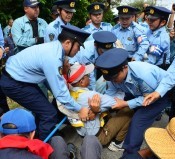
September 28, 2012 Ryukyu Shimpo
From 9:00am on September 28, in front of the Oyama gate of the U.S. Marine Corps Air Station Futenma, about 100 people from civil groups such as the Okinawa Peace Movement Center and labor unions held a rally to protest against the deployment of MV-22 Osprey vertical take-off and landing transport aircraft. The people sat in front of the gate and halted all vehicle traffic in and out of the base for a short time. They got into a shoving match with the police, and at about 11:20am a woman in her 60s was taken away in an ambulance in a confused state. The extent of her injury is unknown at this time.
As of noon, protesters were still sitting in front of the gate. Around 10:30am, Marines closed the Oyama gate of the base. The gates of the Futenma Air Station were blocked by the protest in two places, including the Nodake gate, in the afternoon of September 27. The Marines secured their inbound and outbound traffic through the gate at Samashita.
From 7:00am on September 28, in front of the Nodake gate, the executive committee that organized the Okinawan People Mass Rally on September 9 in Ginowan, held a protest rally. About 300 people, including members of the Diet, prefectural government assembly, and mayors of cities, towns, villages, as well as citizens participated in the rally, demanding that the governments of Japan and the United States abandon the Osprey deployment.
Nago City mayor Susumu Inamine said, “We will not permit the deployment of the Osprey to Futenma Air Station. As was the case in the San Francisco Peace Treaty, the Government of Japan is once again about to detach Okinawa from Japan for the security of the main islands. With this can Japan call itself a democracy, or an independent state? Let’s put up a struggle for democracy from Okinawa, and make the Japanese government open its eyes to the situation.”
(English translation by T&CT, Mark Ealey)
Go to Japanese
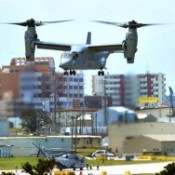
October 2, 2012 Ryukyu Shimpo
On October 1, the U.S. Marine Corps began to deploy MV-22 Osprey vertical take-off and landing transport aircraft to MCAS Futenma. At 7:11am, two MV-22s that had been temporarily at MCAS Iwakuni in Yamaguchi Prefecture, landed at Futenma, and by 11:47am a total of six aircraft had set down at the base. On October 2, three more MV-22s arrived at Futenma, so now nine MV-22s have been deployed in Okinawa.
On September 9, a mass rally was held in Okinawa in which about 103000 people protested against the deployment of the Osprey. A sit-in protest has also continued in front of the gates of the Futenma base. The governments of the United States and Japan have forcibly deployed the MV-22s in Okinawa despite strong protests from the residents. This hard-line approach will provoke a backlash from the people.
The U.S. Marines Corps in Okinawa commented that its MV-22s and crews will begin the routine training, starting flying as early as October 2. In the interest of safety, the United States and Japan agreed that the scope for the MV-22s operating in the helicopter-mode with rotors facing upwards is to be limited to airspace above the base because flight in helicopter-mode is more likely to lead to an accident. However, flights in helicopter-mode have already been confirmed as occurring over populated areas in Ginowan City. The two governments stated that the aircraft will fly over the sea as much as possible, but they have already flown above the Kunigami Municipal Office, so the Marine Corps has operated in a manner contrary to the safety-oriented approach that the governments promised.
Governor Hirokazu Nakaima observed the MV-22s’ flight with Ginowan Mayor Atsushi Sakima from the municipal office building. At a press conference, the governor said, “If the government does not create a situation in which the anxiety of the local residents is completely dispelled, we cannot say that the Okinawan people will accept this airplane that has a history of crashes.” He went on to say, “The government should move the aircraft to another airport in Japan as soon as possible.” The governor also mentioned the relocation of the facilities at Futenma base outside of the prefecture. He will request an appointment with Prime Minister Yoshihiko Noda in order to directly request the withdrawal of the MV-22s.
Naha mayor Takeshi Onaga, who was a co-leader of the Okinawan People Mass Rally, members of the Okinawa Prefectural Assembly and local residents participated in the rally that started from 7:00am in front of the Nodake gate of the Futenma base. There were screams of anger from the participants at 11:10am when one of the group reported that the first of the MV-22s had landed the base. When they saw the planes flying over one after another, they yelled, “Osprey, Go back to the United States,” and “Don’t trample on Okinawa.”
A noise level of 90.2db was recorded when the Osprey passed over the Ojana Community Center in Ginowan. According to a survey carried out by experts, this is about 10db louder than the noise from the current model CH-46 helicopter, which in terms of annoyance factor is equivalent to nearly twice that of the CH-46.
(English translation by T&CT, Mark Ealey)
Go to Japanese

Go To Video
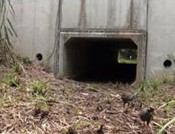
September 21, 2012 Ryukyu Shimpo
Bird crossing tunnels have been set up under Route 58 in Kunigami to protect the endangered Yambaru-kuina, or Okinawa rail, from being hit by cars. Some chicks are confirmed to have passed through the tunnels. Groups and organizations have been working to save the rails. One group took care of a rail that was hit by a car in August and recently released the bird after it recovered. Those involved in the groups urge drivers to be more careful about the birds.
On September 20, the National Highway Office of the Northern Region of Okinawa (NHONO) released results of research into the use by small animals of the special tunnels under Route 58 in Kunigami. Research carried out from May 21 to August 31 revealed that 74 adult rails and, for the first time, that some chicks had used the tunnels.
In 2007 the NHONO put up five fences in Kunigami to prevent Okinawa rails from getting on the national highway. Then in 2010, they created what are called Kuina-tunnels under the fences on a trial basis and have used surveillance cameras to monitor the movement of the birds.
Rail chicks passed through the tunnels three times during the survey, and in June and August, a rail family was filmed in front of the tunnels.
After the tunnels were set up, in 2010, there were accidents in which rails were killed on Route 58. In 2011 were none, but this year three rails were involved in such accidents.
A staff member of the NHONO commented, “We will take measures to protect the Yambaru-kuina based on past experience and consulting with experts.”
(English translation by T&CT, Lima Tokumori and Mark Ealey)
Go to Japanese
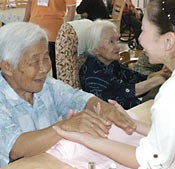
September 18, 2012 Ryukyu Shimpo
On September 17, events for the Respect-for-the-Aged Day were held in all over Okinawa. On Ishigaki, five beauty therapists and manicurists visited Ohama One, a day-care facility, where they gave massages and provided finger-nail service to aged people for free. Seeing the smiling faces of the elderly people was a heart-warming experience for the people who provided the services.
The therapists talked to the elderly as they massaged their faces, hands and feet. The seniors showed their beautiful nails to their caregivers and smiled happily. Ninety-seven year-old Hide Jiroku said, “I am not used to doing my nails because I am an older woman, so today I feel a little embarrassed, but very happy.”
At Uruma, Mayor Toshio Shimabukuro called in to see Kimi Jana, who turned 100 year-old this year and lives in Henza, Yonashiro, to celebrate her longevity. Jana held up her fists to the Mayor and her family, saying, “I am more cheerful than ever.” Everyone laughed with her.
Jana has five children, 15 grandchildren and 15 great-grandchildren. She likes to go to the day-care center twice a week and surprises the workers by adding up three-figure numbers in her head.
In Miyako-jima, the municipal office and local communities held a range of events for the aged. At the Nishihara community center in Hirara, Miyako-jima, a party attended by about 200 senior citizens was held. The Nishihara Women’s
Association arranged the lunches for them.
(English translation by T&CT, Lima Tokumori and Mark Ealey)
Go to Japanese
September 21 Ryukyu Shimpo
On September 20, the Okigin Economic Institute estimated that the 28th All Japan Triathlon Miyakojima pumped about 330 million yen into the Okinawan economy, which increased in activity by 1.7 % over the previous year. The main effects on the economy were in the service, manufacturing and trading industries. Allowing more participants from outside of the prefecture was the reason behind the positive economic effects. At the same time, the participation of low-cost carriers in the travel industry also helped to decrease transport costs.
The added value rate based on the gross production by the prefecture amounted to about 174 million yen, accounting for 0.005% of the gross production of the prefecture in fiscal 2009, and 0.17% of the gross production by Miyako.
A total of 1470 participants took part in the competition, which is up 9.2% on the previous record. There were 1222 participants from outside of the prefecture, accounting for 80% of the total. In addition, there were 114 Okinawan participants from outside of Miyako and 61 participants from overseas. Combined with participants’ family members, 256 media representatives and about 5000 volunteers, the total number of people who attended the event was about 7119, up by 2.1 % on the previous record.
Based on consumption expenditure in Miyako by the participants and the event operating expenses, the institute estimated that the event directly contributed 199 million yen to the prefecture. Inter-industry analysis suggests that the flow-on effect was 8.3 million yen. Furthermore, the institute estimated that the secondary spillover effect, such as additional consumption generated by payment for employment in each industry as 50 million yen.
The institute calculated the economic impact generated during the period from the commendation ceremony to the closing session.
(English translation by T&CT, Mark Ealey)
Go to Japanese











 Webcam(Kokusai Street)
Webcam(Kokusai Street)


